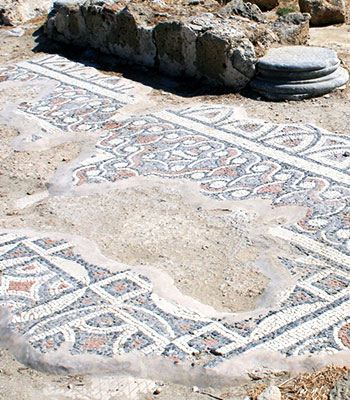 Under the modern settlement of Chersonissos Port, the center of ancient Cheronissos lies. The city had been inhabited since the Minoan years however, it reached its acme at the Hellenistic - Roman and Early Byzantine period, when it was the seat of the homonymous ancient bishopric. In the wider area, three basilicas have been identified, indicative of the great peak of the settlement during the early Byzantine period. The most important finding of this period is the magnificent Early Christian Basilica of Kastri, also known as Basilica B, located on Kastri Hill, in the northern part of the city.
Under the modern settlement of Chersonissos Port, the center of ancient Cheronissos lies. The city had been inhabited since the Minoan years however, it reached its acme at the Hellenistic - Roman and Early Byzantine period, when it was the seat of the homonymous ancient bishopric. In the wider area, three basilicas have been identified, indicative of the great peak of the settlement during the early Byzantine period. The most important finding of this period is the magnificent Early Christian Basilica of Kastri, also known as Basilica B, located on Kastri Hill, in the northern part of the city.
The Basilica in Kastri was found at the beginning of the 20th century by St. Xanthoudidis and was excavated in 1956-1959 by Anastasios Orlandos. According to the archaeologist, Anastasios Orlandos, the Basilica was initially built at the end of the 5th century AD, was destroyed in the 7th century and later rebuilt in smaller dimensions (51,70 × 21,70 m). Its architecture was influenced by Syrian models with an anteroom on its southern side, while it retains fragmentary preserved mosaic floors, with plant and geometric motifs in the central aisle, some of which are preserved in good condition. In front of the apse of the temple, the marble base of the altar, which was a cover of a Roman sarcophagus, was found. On the south side of the sanctuary, a burial chapel carved into the rock was found and is believed that it was either a tomb of a prominent clergyman or a martyr. There were also a marble circular plate decorated with colored marbles, with a carved wreath with its leaves being filled with nacre (mother-of-pearl) taken from the inside part of the mollusk shell (pear shell) and a cross that on one leg forms the letter P, which is the oldest shape of the Christ monogram.
The excavations carried out in 1993 showed that Basilica might have been built on the traces of an earlier one which was collapsed from an earthquake. The first Basilica had approximately the same dimensions as Basilica B. Both Basilicas were built on the ruins of a Hellenistic building, perhaps a sanctuary, dedicated to Artemis Vritomartis, according to the many figurines and objects found during the excavations. The whole complex of the Basilica was surrounded by a wall that surrounded the hill and extended to the northern beach.
Before 616, repairs were made to preserve the temple, the part of the mosaic floor was replaced, and the opening of the central aisle was reconstructed. Its final collapse was probably caused by an earthquake during the reign of Emperor Heraklion (610-641), and later, as it seems, some lodgings were built for local residents from materials taken from the semi-destroyed Basilica.
The excavation revealed the main church, a posterior narthex on one side and the main narthex of a three-nave Basilica. The central nave that ends up to the Altar has two tabernacles (chapels) on its sides, which are connected to the side naves through openings. The narthex has two entrances to the side naves and a tribelon (triple arcade) opening to the main nave. The main nave is separated from the side ones with columns. On the north end point of the main nave, there is a pulpit with stairs, while outside, along the north wall of the Basilica, there is an outbuilding. On the south tabernacle, some Archbishops’ tombs were found. The mosaics in the Altar, the main nave, the north outbuilding, as well as the south tabernacle, where the tombs were found, are remarkably impressive.